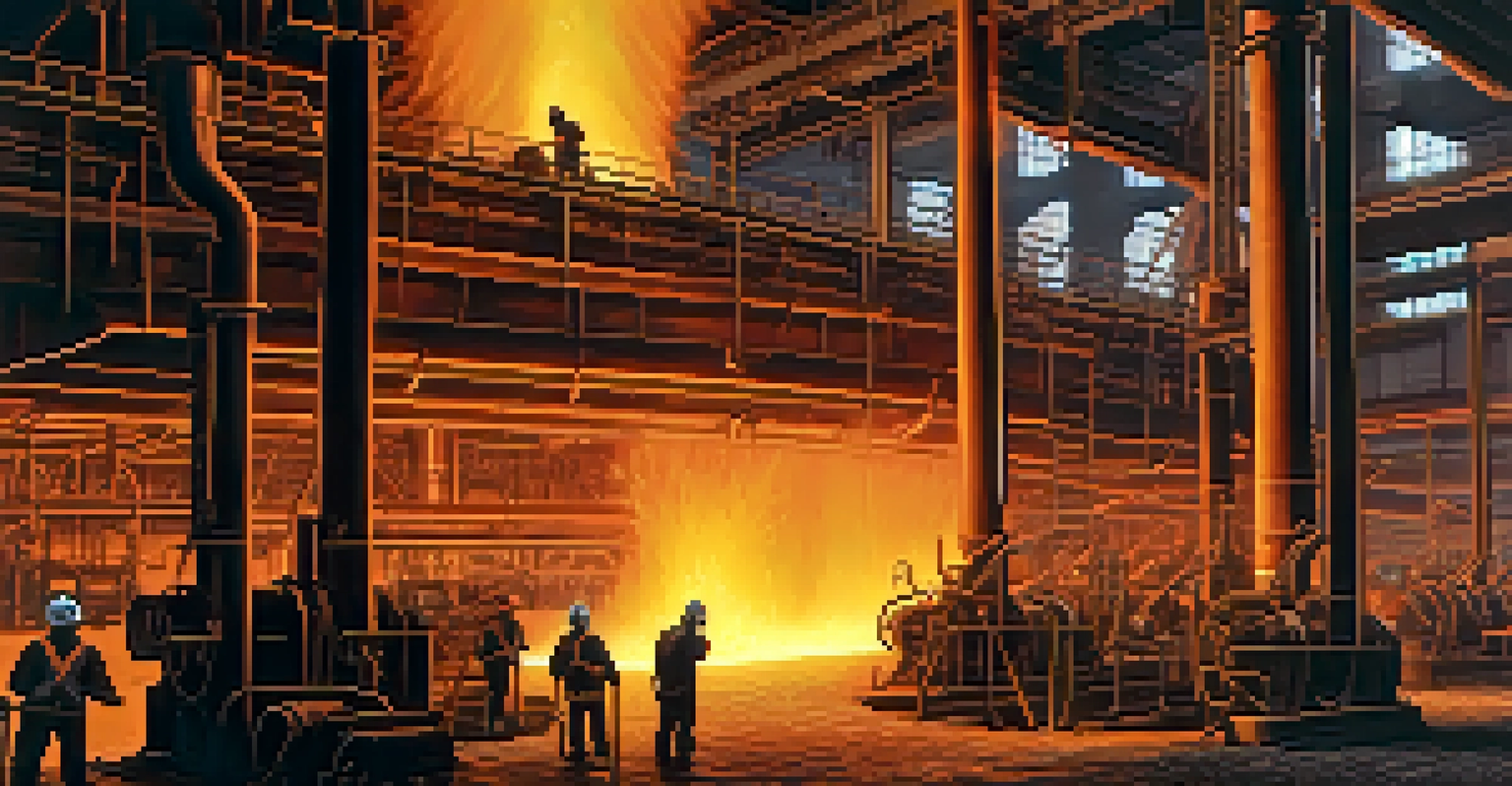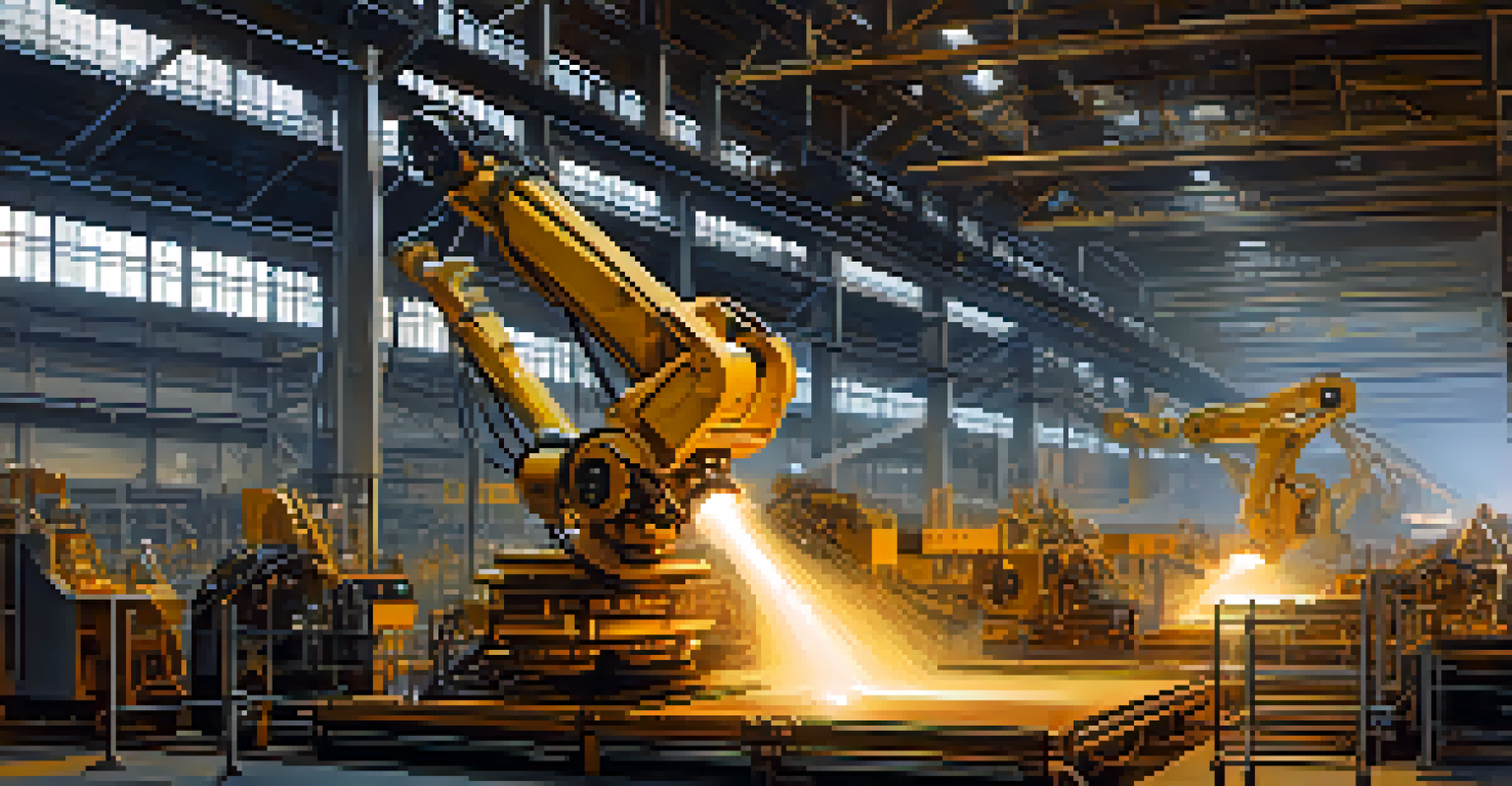Steel Production Techniques: Innovations in Pittsburgh's History

The Birth of Steel Production in Pittsburgh
Pittsburgh's steel industry began in the early 19th century, transforming the city into a manufacturing powerhouse. The convergence of rivers and railroads made it an ideal location for transporting raw materials and finished products. As coal and iron ore became readily available, local entrepreneurs seized the opportunity to establish steel mills, paving the way for a booming industry.
The future belongs to those who believe in the beauty of their dreams.
One of the key figures in this early development was Andrew Carnegie, whose vision and business acumen helped revolutionize steel production. He founded Carnegie Steel Company in 1892, which went on to dominate the market. This period marked the transition from small-scale operations to large, industrialized production, setting the stage for future innovations.
The combination of natural resources and innovative thinkers positioned Pittsburgh as the ‘Steel City.’ This reputation not only attracted workers but also spurred technological advancements that would change the face of metallurgy forever.
The Advent of the Bessemer Process
In the 1850s, the Bessemer process emerged as a groundbreaking technique for steel production. This method allowed for the mass production of steel by blowing air through molten iron to remove impurities. Pittsburgh quickly adopted this technique, significantly increasing the efficiency and quality of steel manufacturing.

With the Bessemer process, steel became more affordable and accessible, igniting a boom in construction and infrastructure development. Bridges, railways, and buildings sprang up, transforming Pittsburgh into a vital hub for industry and trade. The newfound strength and durability of steel opened doors to architectural possibilities that had previously been unimaginable.
Pittsburgh's Steel Industry Origins
Pittsburgh became a manufacturing powerhouse in the 19th century due to its strategic location and the availability of coal and iron ore.
The widespread implementation of the Bessemer process not only revolutionized production but also solidified Pittsburgh's status as a leader in steel innovation. This advancement set the stage for further technological breakthroughs in the years to come.
The Open Hearth Method: A Game Changer
Following the Bessemer process, the open hearth method revolutionized steel production even further in the late 19th century. This technique allowed for greater control over the steel-making process, resulting in higher quality steel with fewer impurities. Pittsburgh's mills quickly adopted this method, further enhancing their competitive edge.
Innovation distinguishes between a leader and a follower.
The open hearth method also enabled manufacturers to use scrap steel, which became increasingly important as demand soared. By recycling materials, Pittsburgh's steel industry not only reduced costs but also addressed environmental concerns, setting a precedent for sustainable practices in manufacturing.
As production capabilities expanded, so did the applications for steel. From the construction of skyscrapers to the manufacturing of railcars, the innovations in steel production transformed Pittsburgh into a symbol of industrial progress.
World War II and the Steel Production Surge
World War II catalyzed an unprecedented surge in steel production, with demand skyrocketing for military equipment and infrastructure. Pittsburgh's steel mills operated around the clock, employing thousands of workers and contributing significantly to the war effort. This period highlighted the city's pivotal role in national defense.
Innovations in production techniques continued during this time, as mills sought to increase efficiency and output. The need for quick turnaround times led to the development of more streamlined processes, including improved blast furnaces and automated systems, which paved the way for modern manufacturing methods.
Innovations Transforming Steel Production
The adoption of the Bessemer process and later the open hearth method revolutionized steel manufacturing, enhancing efficiency and quality.
Post-war, this surge in steel production not only supported the military but also fueled America's economic growth. The infrastructure built during this era laid the foundation for the nation's expansion and prosperity.
Environmental Challenges and Innovations
By the late 20th century, Pittsburgh's steel industry faced significant environmental challenges. Pollution and waste management became pressing issues as the manufacturing processes left a heavy ecological footprint. In response, the industry began to innovate, focusing on cleaner production techniques and sustainability.
One notable development was the adoption of electric arc furnaces, which significantly reduced emissions and energy consumption. These furnaces allowed for the recycling of scrap metal, transforming waste into valuable resources. Pittsburgh's steel mills embraced these innovations, helping to mitigate their environmental impact.
This shift not only improved the industry's image but also aligned it with emerging global standards for sustainability. Pittsburgh began to redefine itself, showcasing how innovation could lead to both economic and environmental progress.
Modern Innovations: Robotics and Automation
Today, Pittsburgh's steel industry is at the forefront of technological advancements, particularly in robotics and automation. Modern steel mills utilize cutting-edge technology to optimize production processes, enhance safety, and improve efficiency. This transition has transformed traditional manufacturing into a high-tech operation.
Robotic systems are now employed for tasks ranging from material handling to quality control, reducing the risk of workplace injuries and increasing output. These innovations not only streamline operations but also allow for precision in production, ensuring that every steel component meets stringent quality standards.
Sustainability and Future Challenges
As environmental concerns rise, Pittsburgh's steel industry is focusing on sustainable practices and adapting to new technologies to remain competitive.
As a result, Pittsburgh has evolved from its industrial roots into a hub for technological innovation in steel production. The city continues to adapt, demonstrating that embracing new technologies is vital for maintaining a competitive edge in the global market.
The Future of Steel Production in Pittsburgh
Looking ahead, Pittsburgh's steel industry faces both challenges and opportunities in a rapidly changing world. The rise of alternative materials and shifts in global demand require the industry to remain agile and innovative. However, the city's rich history of adaptation positions it well to navigate these changes.
Sustainability will remain a key focus, with ongoing efforts to minimize environmental impact and enhance recycling practices. As the world grapples with climate change, Pittsburgh's steel industry will play a crucial role in developing eco-friendly production techniques and sustainable practices.

By leveraging its historical strengths and embracing new technologies, Pittsburgh is poised to remain a leader in steel production. The future seems bright for the Steel City as it continues to innovate while honoring its rich legacy.